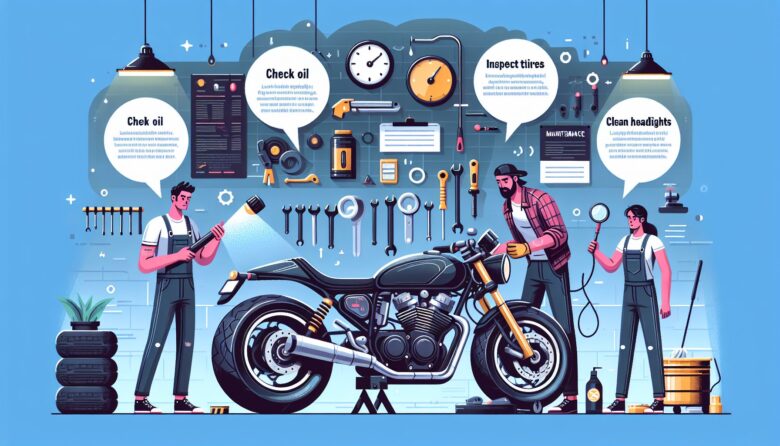Riding a motorcycle isn’t just about the freedom of the open road; it’s also about keeping your machine in peak condition to ensure safety, performance, and longevity. Routine motorcycle maintenance can seem tasking, but it’s essential to the biker experience. Devoting time to your bike’s upkeep is just as important as mastering the art of riding. So let’s “gear up” and delve into the crucial aspects of motorcycle maintenance.
Understanding the Basics of Motorcycle Maintenance
To keep your motorcycle running smoothly, a fundamental understanding of its components and their functions is paramount. Always start with the basics – your motorcycle owner’s manual. This manual is more than just a book that came with your bike; it’s the blueprint for your motorcycle’s health and well-being.
Regular Check-Ups: The Lifeline of Your Machine
Fluids and Filters: The Lifeblood of Your Engine
Much like any living being requires water, your motorcycle needs fluids to operate effectively. Regularly check and change your oil to keep your engine running smoothly. Remember also to attend to other fluids such as coolant, brake fluid, and transmission fluid, as each plays a significant role in the operation of your motorcycle.
Chain, Belt, or Shaft: Keeping Power in Your Ride
The way your motorcycle transfers power from the engine to the rear wheel can vary, but whether it’s through a chain, belt, or shaft drive, it needs your attention. Regularly check for proper tension and lubrication, and adjust when necessary. A chain that’s too loose or too dry can lead to performance issues or even dangerous situations.
Tire Checks: Your Contact with the Road
Tires are your motorcycle’s only points of contact with the road. To ensure your safety and your motorcycle’s handling ability, inspect your tires before every ride. Look for signs of wear, check tire pressure, and understand your tire’s tread limits. Proper tire maintenance can mean the difference between a smooth ride and a potential accident.
Brakes: Your First Line of Safety
Your brakes are one of the most crucial elements of your motorcycle. A simple brake inspection can prevent catastrophic failure. Pay attention to the brake pad thickness and look out for any irregular marks or grooves on the brake discs. Any sponginess in the brake lever or pedal is an indicator that you might need to bleed your brakes or change the fluid.
The Electrical System: Igniting Your Ride
Motorcycles rely on their electrical system for starting up, running lights, and other functions. A battery in good condition is necessary for reliable starting. Keep your battery clean and charged, especially if you don’t ride your motorcycle regularly. Also, routinely check your lights, indicators, and horn to ensure they are fully operational.
Regular Inspections Can Prevent Major Problems
Advanced Tips for the Enthusiast
Air Filters: Breathing Easy
A clogged air filter can choke your motorcycle’s performance and throttle its efficiency. Ensure you check your air filter at regular intervals and replace it according to the manufacturer’s guidelines. Riding in dusty or polluted environments might require you to replace your filter more often.
Spark Plugs: The Fire Starters
Spark plugs are the tiny titans responsible for igniting the mixture of air and fuel within your engine. If your engine is misfiring or if it’s difficult to start, your spark plugs might be to blame. Check and replace your spark plugs if they show signs of wear, damage, or carbon build-up.
Suspension: Smoothing Out the Ride
For a comfortable ride, your motorcycle’s suspension system needs to support not just your weight but the dynamic loads that come with riding. Regularly examine your forks, shocks, and springs for any signs of oil leaks, damage, or abnormal compression. Adjust your suspension according to the load you’re carrying and the conditions in which you’re riding.
Seasonal Tips for Motorcycle Maintenance
Winter Woes: Protecting Your Bike in the Cold
For many riders, winter means storing the motorcycle until warmer days come along. Use this time for an in-depth maintenance check. A thorough cleaning and a coat of wax can protect your bike’s surface. The battery should be kept charged, and fluids should be topped up or replaced if there’s any risk of freezing.
Summer Prep: Getting Ready for High Temperatures
Summer spells long rides and high temperatures. Your motorcycle’s cooling system will have to work harder to prevent overheating. Check your coolant levels and the radiator for any debris that may block airflow. Additionally, an oil change prior to the summer seasons can be beneficial as higher temperatures can affect oil viscosity.
Troubleshooting Common Issues
Listening to Your Motorcycle
Often, your motorcycle will tell you when something’s not right. Squeaks, rattles, and other strange noises shouldn’t be ignored. They can be early warning signs of issues that, if addressed quickly, can prevent further damage or more expensive repairs.
When to Seek Professional Help
While many aspects of motorcycle maintenance can be handled by the rider, occasionally you may encounter issues that call for professional expertise. Recognizing when you’re out of your depth and bringing your motorcycle to a certified mechanic can save you time and prevent worsening the problem.
The Ride Ahead: Maintaining for the Future
Investing time in regular maintenance can extend the life of your motorcycle and improve your riding experience. Use this guide as a roadmap for your journey in motorcycle maintenance, and remember, the more love you show your machine, the more reliability and enjoyment it will offer you in return. Embrace the routine checks, understand the importance of each component, and address issues promptly to ensure countless miles of memorable and safe adventures on the open road.




